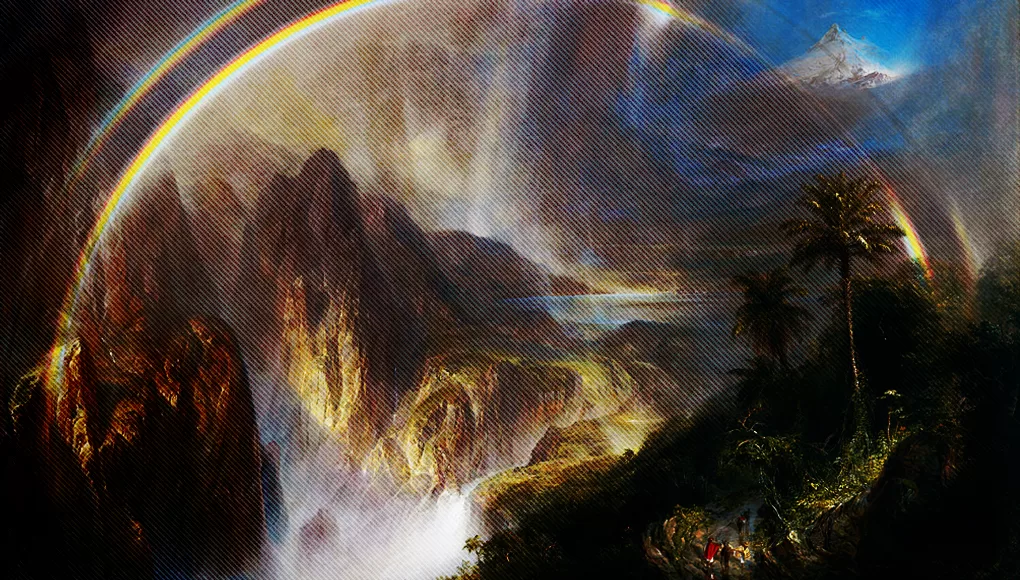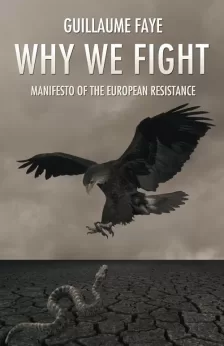It is altogether characteristic that, contained within an entire group of extremely recent studies on prehistory, ancient ideas should make a new appearance, despite the fact that up until yesterday these were considered to be pure myths.
One of these ideas refers to the legendary primordial land of the Hyperboreans. A number of researchers has taken up precisely this idea, thereby calling into doubt the presumed certainty that a simian humanity was the only kind of humanity to exist in prehistory, and going so far as to confront the problem of origins from a new and unprejudiced view, to the point of expressing the suspicion that the Stone Age might be testimony to an authentic civilization of a superior, symbolic-spiritual kind. The Arctic, the North Pole, the fabulous Hyperborea was evidently the primordial fatherland of a highly civilized prehistoric white race – so civilized indeed that it was considered ‘divine’ by the ancients.
The seeming paradox of this thesis disappears soon as one recalls what physics teaches regarding the so-called ‘procession of the equinoxes’. On account of the inclination of the terrestrial axis, the climate of the Earth shifts from epoch to epoch. Given that hard coal has been rediscovered beneath the polar ice, this means that there were once forests and fires in the arctic zone. The freeze would not have come upon the arctic zone save in a later period. One of the designations for Asgard, home of the ‘divinities’ and original fatherland of the royal Nordic lines, according to the Scandinavian traditions, is the ‘green isle’ or ‘green land’, in modern German grünes Land, and hence Greenland. But this land, as its very name shows, seems even in the time of the Goths to have had a vigorous vegetation, and to have not been entirely covered in the freeze. But there is more: in the region of the arctic ice, the recent expedition of the Canadian Jenness, the Danes Rasmussen and Therkel, and the American Birket-Smith made some truly singular archaeological discoveries:1 deep beneath the ice, the remains of a civilization of much higher level than that of the Eskimos, and relicts yet more ancient, prehistoric. The name of the civilization of Thule was given to this civilization.
Thule is the name that the Greeks applied precisely to a region or island of the far north, one often confounded with the lands of the Hyperboreans, whence came the solar Apollo – that is the god of the Doric-Achaean races who descended from the north into Greece. And Plutarch says of Thule that the nights there, for about a month, lasted only two hours: this is precisely the ‘white night’ of the northern countries. And the fact that other Hellenic traditions call the northern sea the Chronid Sea, that is the Sea of Chronos (Saturn), is another significant indication, since Chronos was conceived as one of the gods of the Golden Age, that is the primordial age, the age before humanity.
Now, if we travel to America, we find correspondences in the Aztec civilizations of Mexico so remarkable that they extend even to names. Indeed, the ancient Mexicans called their primordial fatherland Tlapallan, Tullan and also Tulla (the Hellenic Thule).2 And just as the Hellenic Thule was related to the solar Apollo, so the Mexican Tulla was also considered the ‘House of the Sun’.
But let us compare these Mexican traditions with the Celtic. If the most distant progenitors of the Mexicans came to America from some Nordic-Atlantic Land, here too the Irish legends speak to us of the ‘divine race’ of the Tuatha dè Danann, which came to Ireland from the West, from a mystical Atlantic or Nordic-Atlantic land, Avalon. These would appear to be, therefore, two forms of one and the same memory. The two civilizations would correspond to two irradiations, the one American, the other European, taking their point of departure from one and the same centre, from one and the same vanished source (the myth of Atlantis), or else from a source that froze over. But there is more, insofar as, if we depart the field of positive modern investigations, we will find elements that might easily accord with these legendary echoes. Indeed, on the Atlantic European littoral (above all in the so-called culture of the Magdalenes) there are very clear traces of an authentic civilization and of a kind of humanity – the so-called Cro-Magnon man – that appears to have developed in a superior way as compared to the almost animal races of the so-called ‘glacial’ or ‘Mousterian man’ who lived at that time in Europe. The fragments that have come down to us of this civilization are of such a nature as to bring certain researchers to declare that the Cro-Magnons could certainly be considered the Hellenes of the Stone Age. Now, might not this race of Cro-Magnons, which appeared enigmatically in the Stone Age along the Atlantic littoral among inferior and almost simian races, be identical to the Tuatha dè Danann, the ‘divine race’ come from the mysterious Nordic-Atlantic land, of which the Irish legends make mention? And as for the myths regarding the fight between the suddenly arising ‘divine races’ and the races of ‘demons’ or monsters, might these not be best interpreted as the fantastic echoes of the battle waged between those two races, between the Cro-Magnon men, ‘the Hellenes of the Stone Age’, and the bestial ‘Mousterian’ men?
The results of the research of Wirth,3 in short, are apparently these: that in the highest prehistory – around 20,000 B.C. – a great unified white race, of the solar cult, was pressed out of the polar region, which had become uninhabitable on account of the freeze, toward the South, into Europe and America, but above all into a land which has disappeared, positioned to the North of the Atlantic. From this land, this race evidently subsequently moved, in the Palaeolithic Period, toward Europe and Africa, with a movement, in any case, from the West to the East; it evidently penetrated into the Mediterranean basin, creating a cycle of prehistoric civilizations which were intimately related to one another, in whose family are included the Egyptian, the Etruscan-Sardinian, the Pelasgian, etc., not to speak of others yet that new waves would found in their advance across the continent, going so far as to reach the Caucasus and then beyond, up to India, and even to China. Thus, that which has been held to be the ‘cradle of humanity’, the tablelands of Pamir, would be only one of the fairly recent centres of the radiation of an elder race. The Arian and Indo-Germanic races, Homo eurapaeus in general, would be races already derived and in a certain sense already mixed compared to the older and purer lines, the ‘Hyperboreans’, to whom are related prehistoric memories, symbols and even the stone representations of the ‘conquerors come on great foreign vessels’, of the ‘axe’, of the ‘sun’ and of the ‘solar man with raised arms’. A mysterious unity would in this way draw together a group of great civilizations and ancient religions, which were already flourishing in areas wherein even yesterday one posited the presence of animal-like cavemen.
This is, in brief, the strange and evocative conception which, drawing from the world of myth, is today once again coming to light: the Arctic, the first fatherland of humanity, indeed of ‘solar’ civilization, in the highest sense.
And since symbol summons symbol, let us recall this in closing: even in the Roman epoch, the idea of the region of the north as a mystical country, inhabited by the ‘father of the gods’, by the numen of the first age or the golden age, the idea that the almost nightless Arctic day was not unrelated to the perennial light that envelops the immortals – such ideas were so alive in the Roman epoch that, according to the word of Eumenius,4 Constantius Chlorus, confusing Great Britain with Thule, even directed an expedition toward the north of Great Britain, not so much out of desire for military glory but to reach the land ‘that more than any other is near the sky’ and almost sensing the divine transfiguration that, it was believed, the Heroes and the Emperors underwent at their death.
Now, these same regions, which saw the dawning of humanity, and which enclose the mystery of a race of primordial white conquerors whose symbol, the axe, is to be rediscovered moreover in the very Roman symbol of the fasces5 – these same Nordic-Arctic regions, from the island of Greenland to North America, are the very same that have been victoriously surveyed very recently from the air by the Italians, in a feat which has something fateful about it, and which bound itself enigmatically precisely to places of a primordial greatness.6
References:
1Reference in fact to an entire series of expeditions, seven in total, performed between 1912 and 1933, by a number of explorers, including those named here: Diamond Jenness (1886–1969), Knud Rasmussen (1879–1933), Therkel Mathiassen (1892–1967), and Kaj Birket-Smith (1893–1977). Knud Rasmussen was the organizer of these expeditions, and the only one to venture out on all of them. The self-proclaimed task of the later expeditions in particular was to uncover the civilizational origins of the Eskimo people. The name of Thule was given reflexively to the discoveries that resulted, since in fact it had actually been merely the name of the original trading station established by Rasmussen and his friend Peter Freuchen, which was named ‘Ultima Thule’ on account of its being the northernmost trading post in the world. Evola probably has in mind here specifically the ‘Fifth Thule Expedition’ of 1921 to 1924, which was by far the most successful, productive and well-documented of these expeditions. Several minor errata: Evola evidently confounds the name and surname of Therkel Mathiassen, and Birket-Smith was in reality a Dane and not an American.
2The name is today commonly transliterated as ‘Tollan’; this obviously in no way discredits Evola’s etymological suggestion.
3Herman Wirth (1885–1981) was a Dutch-German historian who dedicated many of his studies to ancient religions and their symbols, as well as to racial studies, particularly surrounding the Nordic races. Evola makes frequent mention of him in his works, and discusses his ideas at some length in Chapter VII of The Myth of the Blood, in which he reviews a number of ideas related to those presented in this article. Although Wirth received a degree of early acclaim from the Nazis and even from Hitler himself, his attempt to interpret Christianity in the light of a Nordic faith led to his falling out of favour when the neo-pagan strands of Nazi thought began to rise to prominence. His 1928 work Der Aufgang der Menschheit (The Accession of Mankind) has yet to be translated into English.
4The original has ‘Eumanzio’, but this is surely the figure meant: Eumenius, the Roman panegyrist born between 230 and 260 AD. The present reference is probably taken from Eumenius’ Pro restaurandis scholis, in which he lauds the Emperor Constantius I, otherwise known as Constantius Chlorus (250–306), father of Emperor Constantine.
5A Latin term indicating a bundle of rods bound together with an axe, symbol of the authority invested in the civil magistrate. Evola uses the Italian fascio here, the term from which the name ‘Fascism’ arose in self-conscious reference to the Roman tradition.
6Probable a reference to two flights (1926 and 1928) over the North Pole in dirigibles conducted by General Umberto Nobile, with the Norge and the Italia, respectively. The former was probably the first aircraft to reach the North Pole. The latter ended in a polar crash and an expensive rescue operation, a misadventure from which General Nobile emerged with reputation unscathed and body sporting only several broken bones.








Fascinating
Global warming is our friend! a Return of our Northern paradises!